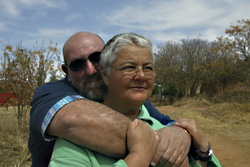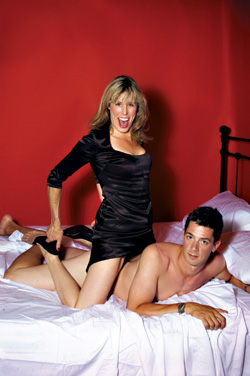At Ballard High School’s winter formal this year, Miles Rydinski was living the dream. He and his date were getting down on the dance floor, grinding along to some hip-hop, lost in a moment of teenage euphoria. But about 30 minutes before midnight, a chaperone broke into the circle Miles was dancing in and tapped him on the shoulder. Miles and his date were forced to leave.
The same thing had happened at homecoming a few months before, giving Miles, an otherwise well-behaved, college-bound senior, the dubious honor of going two for two in getting kicked out of school formals. “Everyone was breaking the rules,” Miles says. “It’s way more fun when the girl’s getting wild.”
Efforts to curb freaking—which most students just call “dancing,” drawing no distinction between the two—in Seattle schools aren’t new, and barring a sudden rise in the popularity of contra dancing, likely won’t end anytime soon. But in the thick of prom season, high schools are trotting out new strategies.
For its upcoming prom, Cleveland High School has hired DJ Super Dave, who specializes in school events. “I can tell if they want to freak before they do,” says Super Dave. “So I’ll get on the mike and remind them to keep it clean, or put on some old-school stuff like MC Hammer or Vanilla Ice. It’s just a sixth sense. I know what songs to pick and what not to pick.”
At April’s spring tolo, Inglemoor High brought in Dance Dance Revolution games, for which freaking isn’t one of the moves. And the school will hold its prom at the Experience Music Project, hoping the exciting exhibitions will distract students from riding dirty. “We’re trying to think of some alternatives to just dancing,” says Sally Barnum, Inglemoor’s activities coordinator for the past 34 years.
In 2005, Seattle School District’s chief academic officer, Steve Wilson, issued a memo prohibiting freak dancing, but left it up to individual schools to both define and police it. In practice, Seattle school administrators define freaking a bit like they do pornography—you know it when you see it—but there are some general prohibitions: dancing against a wall, grabbing ankles, hands below the knees, the use of chairs or other furniture for impromptu lap dances, pantomiming of sex acts, trains, or contact between any areas that a bathing suit would cover. Ingraham High School has even created a mnemonic device to help its students remember: “Face to face and leave some space.”
“It sounds horrible to describe,” chuckles Amy Baeder, a science teacher and senior-class co-adviser at Cleveland. “It’s just as embarrassing for the adults as for the kids.”
The guidelines don’t always do the trick, though. While patrolling Ingraham’s dances, Traci Huffer, the school’s activities coordinator, sometimes catches her student-government officers leading the freaking. “They can’t help themselves,” she says. “They’re like, ‘Sorry, Mrs. Huffer.'”
Huffer prefers to use school staff rather than parents as chaperones. “What a parent might think is so unacceptable, we kind of go, ‘No, it’s about right,'” Huffer explains.
Two years ago, Ballard administrators received enough complaints—from staff as well as parents—to try to contain the problem. Activities coordinator Kevin Wynkoop urged student leaders to come up with a reasonable plan to present to the administration. “If you don’t,” he advised, “they’ll just come down very hard. It’s much easier for them to just cancel the dances.”
So instead of adopting a rhyming reminder, the students discussed what was obscene and what was extreme. “We all agreed that a girl bent over, touching the ground, that’s inappropriate,” says Wynkoop. “So the question was: When does it become appropriate?”
The school eventually adopted the “45-degree rule”: Anyone whose torso was more than 45 degrees from perpendicular to the ground was too low and risked getting kicked out. (No, adults don’t patrol the dance floor armed with protractors.) “Certainly, the rule doesn’t stop all dirty dancing, but it’s something we can define,” says Wynkoop.
Last year, Ballard also added a penalty box. Students who didn’t follow the dancing guidelines were forced to sit out the rest of the song, as well as the next one. But that, according to Wynkoop, proved to be a logistical nightmare, requiring a separate room (far enough away from the dance so students couldn’t hear the music), someone to supervise the room, and also tracking how many strikes each couple had. “It was just cumbersome,” says Wynkoop. The school scrapped the idea after the school year.
At Ballard’s homecoming dance this fall, so many students were removed that the ones who were left had little incentive to stick around. “Teens will jump on perceived injustice faster than anything else,” says Wynkoop. “So everyone else said, ‘This dance is lame, so we’ll dance nastier than ever, and get thrown out and go home.’ Then there needs to be additional punishment, so we added lunch duty.”
Cleveland’s Baeder says it’s been more than a year since any of her school’s dances reached its scheduled close. Instead, school officials have had to shut down the dances once the freaking got out of hand. After a debaucherous homecoming dance this fall, the school tried to make a statement by canceling the winter formal, leaving Cleveland with just two dances for the year. “I don’t think that really works,” says Baeder. “From the kids’ perspectives, that isn’t a way for them to change. They just get frustrated and wonder why there aren’t dances.”
Canceling dances also eliminates a major revenue source for student groups, which can make thousands of dollars in one night by putting on a dance. Each class typically gets to host a dance, and banks the profit to help pay for things like a prom when they become seniors. After the homecoming dance got out of hand this year, Franklin High School canceled the next two tolos, meaning the junior and sophomore classes lost out.
This year, at least three Seattle schools are requiring students to sign a contract, when they buy their tickets or at the door, promising to abide by dance guidelines. That effectively serves as their warning, and if they don’t honor their contracts, they get the boot. When Franklin canceled the two tolos, it also instituted contracts for last week’s prom. Everyone abided by the terms, says Gen Saechao, a Franklin senior and student body representative. “Nobody got kicked out.”
Students attending Ballard’s prom next month will have to sign contracts as well, though the formal clothing tends to discourage freaking. “Maybe I’ll let them get a little further than I normally would,” says Wynkoop. “I’m not going to jump on someone as soon as they hit 46 degrees. But we also have to be consistent, or else you can’t have rules.”
The students, of course, don’t see what the big deal is, claiming that their dancing merely reflects the times. “I just think of it purely as fun when I’m doing it,” says Libbie Martin, a Ballard senior who was dismissed from the homecoming dance. “I get both sides of the story. To think that women have come so far and here they are bent over for the guy, it’s crude—I understand that. But this is part of our culture, and the kind of music they play encourages this dancing. If waltzing was in, I’m sure that’s what I’d be doing.”
Miles says he plans on attending the Ballard prom and won’t hold back. He simply hopes that if he decides to get freaky, an adult won’t be watching. “It’s not like I’m going to [tell my date], ‘Please refrain from bending down and straighten your back,'” he laughs.








